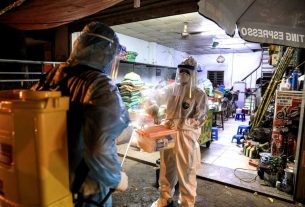![]() Aspergillus fumigatus growing on a petri dish. Photo: Jan-Peter Kasper, University of Jena. (FILE)
Aspergillus fumigatus growing on a petri dish. Photo: Jan-Peter Kasper, University of Jena. (FILE)
Tue 21 March 2023:
The US Centers for Disease Control and Prevention (CDC), which is monitoring the fungus, has warned that a mysterious and deadly infection known as Candida auris is rapidly spreading across the USA.
The development comes on the heels of the World Health Organization last year listing C auris as one of 19 fungal priority pathogens.
The multidrug-resistant yeast was first identified in Japan 15 years ago. It has infected as many as 2,377 people in the US in 2022, according to the Wall Street Journal. New research by the CDC published in the Annals of Internal Medicine shows that in 2021, the health centres in the country reported a 95 per cent increase in cases between 2019 and 2021. For comparison, the fungus had only infected 53 people in the US in 2016.
Additionally, a total of 28 states and the District of Columbia have confirmed reporting the infections – suggesting the current safety measures were not effectively helping tackle the fungus.
About 30% to 60% of infected people have died from the yeast, though that is “based on information from a limited number of patients,” the CDC said. People who are old or have compromised immune systems are particularly more vulnerable after contracting the fungus.
It causes bloodstream wounds and ear infections and has also been found in urine and respiratory samples, but it’s not clear if the fungus actually infects the lung or bladder.
Not only does this yeast cause serious illness in patients but it is also hard to identify without the proper tests.
“Specialised laboratory methods are needed to accurately identify C. auris. Conventional laboratory techniques could lead to misidentification and inappropriate management, making it difficult to control the spread of C. auris in healthcare settings,” said CDC in a circular.
A 2022 study stated that the fungus had spread to more than 30 countries since its first sighting in 2009.
“The reported interregional spread as well as regional endemicity in one country show that C. auris is in the process of establishing itself as a healthcare-associated pathogen in the EU/EEA, similar to other countries such as the United States,” read the report.
The COVID-19-related reuse of PPE and other medical equipment in crowded hospitals has been blamed by the CDC for the sudden increase in yeast infections.
The majority of C. auris infections are treated with an antifungal drug class known as echinocandins. However, in some cases, the fungus has demonstrated extreme resistance to all three major classes of antifungal medications, making treatment more difficult.
SOURCE: INDEPENDENT PRESS AND NEWS AGENCIES
___________________________________________________________________________________________________________________________________
FOLLOW INDEPENDENT PRESS:
TWITTER (CLICK HERE)
https://twitter.com/IpIndependent
FACEBOOK (CLICK HERE)
https://web.facebook.com/ipindependent
Think your friends would be interested? Share this story!





